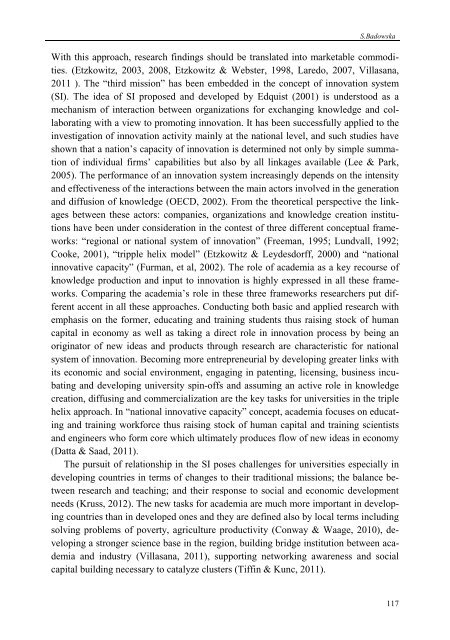Creating-entrepreneurial-mindset
Creating-entrepreneurial-mindset
Creating-entrepreneurial-mindset
- No tags were found...
You also want an ePaper? Increase the reach of your titles
YUMPU automatically turns print PDFs into web optimized ePapers that Google loves.
S.BadowskaWith this approach, research findings should be translated into marketable commodities.(Etzkowitz, 2003, 2008, Etzkowitz & Webster, 1998, Laredo, 2007, Villasana,2011 ). The “third mission” has been embedded in the concept of innovation system(SI). The idea of SI proposed and developed by Edquist (2001) is understood as amechanism of interaction between organizations for exchanging knowledge and collaboratingwith a view to promoting innovation. It has been successfully applied to theinvestigation of innovation activity mainly at the national level, and such studies haveshown that a nation’s capacity of innovation is determined not only by simple summationof individual firms’ capabilities but also by all linkages available (Lee & Park,2005). The performance of an innovation system increasingly depends on the intensityand effectiveness of the interactions between the main actors involved in the generationand diffusion of knowledge (OECD, 2002). From the theoretical perspective the linkagesbetween these actors: companies, organizations and knowledge creation institutionshave been under consideration in the contest of three different conceptual frameworks:“regional or national system of innovation” (Freeman, 1995; Lundvall, 1992;Cooke, 2001), “tripple helix model” (Etzkowitz & Leydesdorff, 2000) and “nationalinnovative capacity” (Furman, et al, 2002). The role of academia as a key recourse ofknowledge production and input to innovation is highly expressed in all these frameworks.Comparing the academia’s role in these three frameworks researchers put differentaccent in all these approaches. Conducting both basic and applied research withemphasis on the former, educating and training students thus raising stock of humancapital in economy as well as taking a direct role in innovation process by being anoriginator of new ideas and products through research are characteristic for nationalsystem of innovation. Becoming more <strong>entrepreneurial</strong> by developing greater links withits economic and social environment, engaging in patenting, licensing, business incubatingand developing university spin-offs and assuming an active role in knowledgecreation, diffusing and commercialization are the key tasks for universities in the triplehelix approach. In “national innovative capacity” concept, academia focuses on educatingand training workforce thus raising stock of human capital and training scientistsand engineers who form core which ultimately produces flow of new ideas in economy(Datta & Saad, 2011).The pursuit of relationship in the SI poses challenges for universities especially indeveloping countries in terms of changes to their traditional missions; the balance betweenresearch and teaching; and their response to social and economic developmentneeds (Kruss, 2012). The new tasks for academia are much more important in developingcountries than in developed ones and they are defined also by local terms includingsolving problems of poverty, agriculture productivity (Conway & Waage, 2010), developinga stronger science base in the region, building bridge institution between academiaand industry (Villasana, 2011), supporting networking awareness and socialcapital building necessary to catalyze clusters (Tiffin & Kunc, 2011).117





